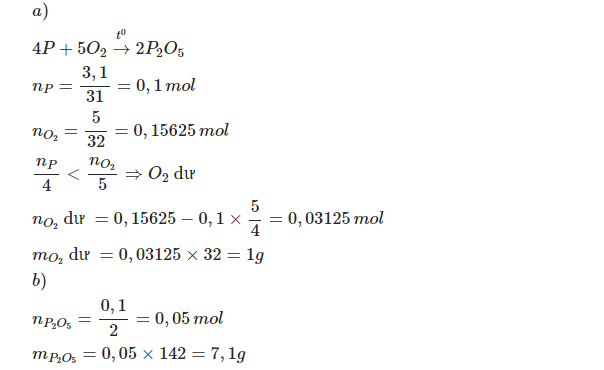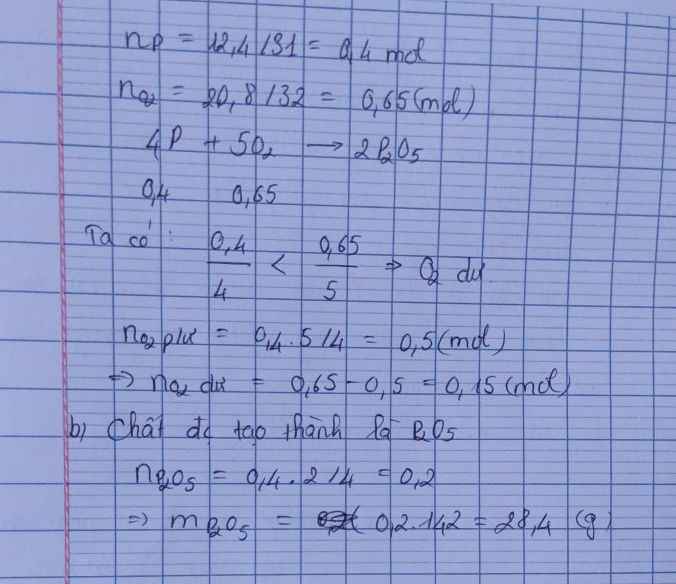Hãy nhập câu hỏi của bạn vào đây, nếu là tài khoản VIP, bạn sẽ được ưu tiên trả lời.

a. \(n_{Mg}=\dfrac{m}{M}=\dfrac{4,8}{24}=0,2\left(mol\right)\)
\(n_{O_2}=\dfrac{V}{22,4}=\dfrac{2,24}{22,4}=0,1\left(mol\right)\)
PTHH: \(2Mg+O_2\rightarrow^{t^0}2MgO\)
-Theo PTHH: 2 1 2 (mol)
-Theo đề bài: 0,2 0,1 (mol)
-So sánh tỉ lệ số mol đề bài với số mol phương trình của Mg và O2 có:
\(\dfrac{0,2}{2}=\dfrac{0,1}{1}\)
\(\Rightarrow\) Mg và O2 phản ứng hết.
b. -Chất tạo thành: Magie oxit.
\(n_{MgO}=\dfrac{0,1.2}{1}=0,2\) (mol)
\(\Rightarrow m_{MgO}=n.M=0,2.40=8\left(g\right)\)

4P + 5O2 -----to---> 2P2O5
0,4---0,5-----------> 0,2 (mol)
+ n P = 12,4 / 31 = 0,4 (mol)
+nO2 = 13,44 / 22,4 = 0,6 (mol)
Vì nP/4 = 0,1 < n O2 /5 = 0,12
=> Oxi còn thừa sau phản ứng .
mO2 dư = (0,6 - 0,5 ) . 32 = 3,2 (g)
b. chất tạo thành : P2O5
mP2O5 = 0,2 . ( 2.31 + 16 . 5 ) = 28,4 (g)
\(n_P=\dfrac{12,4}{31}=0,4\left(mol\right)\\
n_{O_2}=\dfrac{13,44}{22,4}=0,6\left(mol\right)\\
pthh:4P+5O_2\underrightarrow{t^o}2P_2O_5\\
LTL:\dfrac{0,4}{4}< \dfrac{0,6}{5}\)
=> Oxi dư
\(n_{O_2\left(p\text{ư}\right)}=\dfrac{5}{4}n_P=0,5\left(mol\right)\\
m_{O_2\left(d\right)}=\left(0,6-0,5\right).32=3,2\left(g\right)\\
n_{P_2O_5}=\dfrac{1}{2}n_P=0,2\left(mol\right)\\
m_{P_2O_5}=0,2.142=28,4\left(g\right)\)

a) $n_P = \dfrac{12,4}{31} = 0,4(mol) ; n_{O_2} = \dfrac{13,44}{22,4} = 0,6(mol)$
$4P + 5O_2 \xrightarrow{t^o} 2P_2O_5$
Ta thấy :
$n_P : 4 < n_{O_2} : 5$ nên $O_2$ dư
Điphotpho pentaoxit được tạo thành
$n_{P_2O_5} = \dfrac{1}{2}n_P = 0,2(mol)$
$m_{P_2O_5} = 0,2.142 = 28,4(gam)$

4P + 5O2 -> 2P2O5
nP=\(\dfrac{6,2}{31}=0,2\left(mol\right)\)
nO2=\(\dfrac{7,84}{22,4}=0,35\left(mol\right)\)
Vì \(\dfrac{0,2.5}{4}< 0,35\) nên Oxi dư 0,1(mol)
mO2=32.0,1=3,2(g)
b;
Theo PTHH ta có:
nP2O5=\(\dfrac{1}{2}\)nP=0,1(mol)
mP2O5=142.0,1=14,2(g)

\(n_P=\dfrac{m_P}{M_P}=\dfrac{12,4}{31}=0,4mol\)
\(n_{O_2}=\dfrac{m_{O_2}}{M_{O_2}}=\dfrac{17}{32}=0,53125mol\)
\(4P+5O_2\rightarrow\left(t^o\right)2P_2O_5\)
0,4 < 0,53125 ( mol )
0,4 0,5 0,2 ( mol )
\(n_{O_2\left(du\right)}=0,53125-0,5=0,03125mol\)
Chất được tạo thành là P2O5
\(m_{P_2O_5}=n_{P_2O_5}.M_{P_2O_5}=0,2.142=18,4g\)

a/ PTHH: 4P + 5O2 ===> 2P2O5
( Tính khối lượng oxi tham gia phản ứng bạn nhé!!!)
Áp dụng định luật bảo toàn khối lượng, ta có
mO2 = mP2O5 - mP= 142 - 62 = 80 gam
b/ => Khối lượng không khí đã đưa vào bình là:
mkhông khí = \(\frac{80.100}{25}\) = 320 gam
Chúc bạn học tốt!!!
a) Viết PTHH:
Bước 1: Viết sơ đồ phản ứng
P+ O2 ---> P2O5
Bước 2: Cân bằng số nguyên tử mỗi nguyên tố:
4 P+ 5 O2 ---> 2 P2O5
Bước 3: Viết PTHH
4 P+ 5 O2 -> 2 P2O5
Khối lượng của khi oxi khi tham gia phản ứng là:
Theo định luật bảo toàn khối lượng, ta có:
mP+ m(O2)= m(P2O5)
=> m(O2)= m(P2O5)- mP= 142-62=80 (g)
b) Khối lượng không khí đưa vào bình là:
mkhông khí= \(\frac{80.100}{25}\)= 320 (g)

nS=mS/MS=3,2/32=0,1(mol)
nO2=VO2/22,4=32/22,4=1,42(mol)
PTHH: S + O2 --> SO2 (1)
BĐ: 0,1 1,42
PỨ: 0,1-->0,1-->0,1
SPỨ: 0--->1,32-->0,1
a) Từ PT(1)=>O2 dư
VO2(dư)=nO2(dư) .22,4=1,32 .22,4=29,568(l)
b) Từ PT(1)=>nSO2=0,1(mol)
=>mSO2=n.M=0,1 .64=6,4(g)
Mình sửa lại nha mình nhầm ạ


ta có : nP=9,3:31=0,3 mol
nO=5,6:22,4=0,25 mol
PTHH: 5O2 + 2P\(\rightarrow\) 2P2O5
ban đầu: 0,25 0,3 (mol)
phản ứng: 0,25 \(\rightarrow\) 0,25 (mol)
sau phản ứng: 0 0,05 0,1 (mol)
vậy sau phản ứng O2 hết còn P dư
mP dư= 0,05.31=1,55 g
b) chất P2O5
mP2O5= 0,1.390=39 g
Cân bằng sai rùi kìa